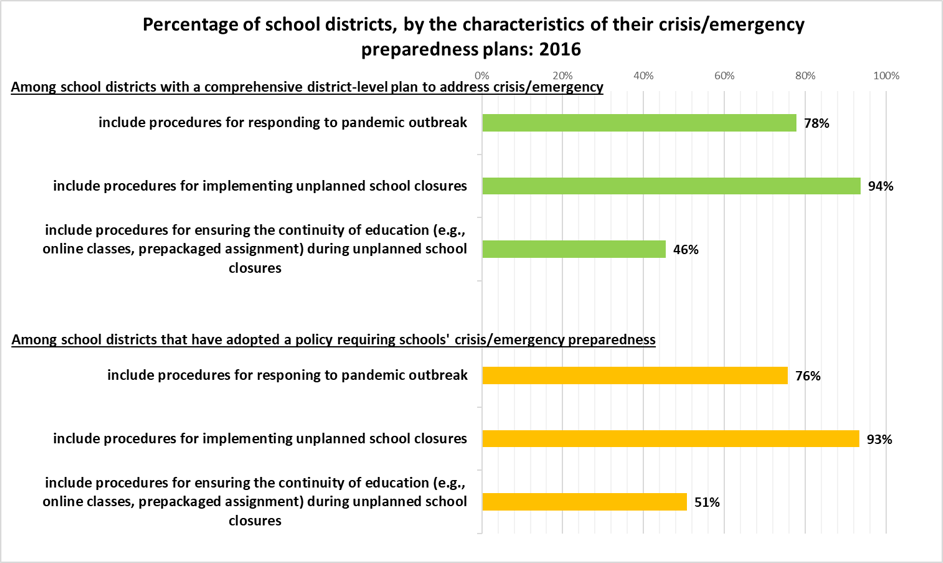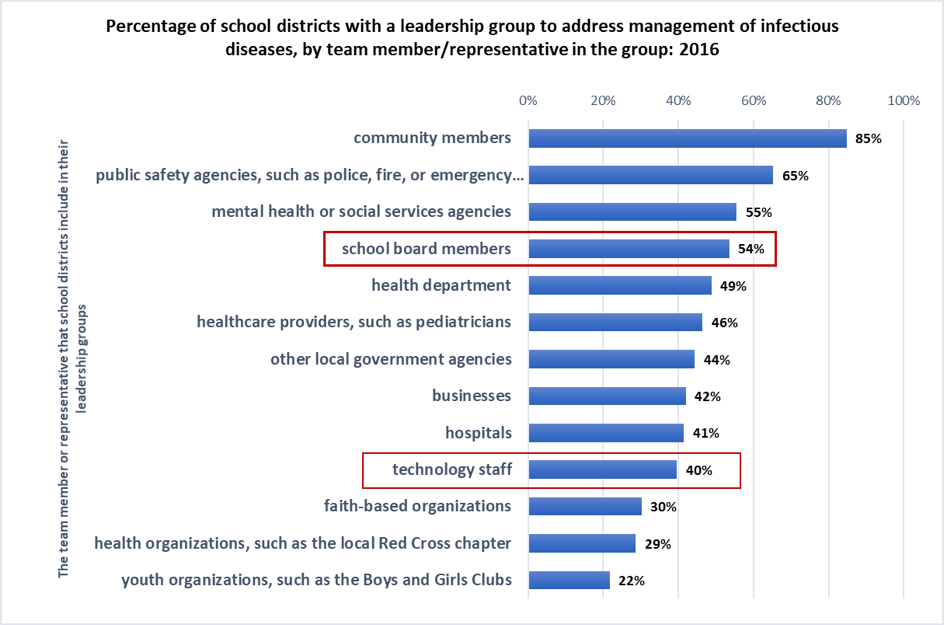“The fact that there was no catastrophic pandemic in recent history does not mean there won't be another one. And we are certainly not prepared for the next pandemic.” Bill Gates said this during an interview in 2017. While the comment was about developing vaccines, today’s world is witnessing inadequate preparedness from the medical to educational fields. The current U.S. response to the coronavirus pandemic has caused thousands of schools to be closed in vast majority of states, including Kansas which has already announced schools are closing for the year.
Closing schools is a drastic but important step to prevent further spread of the coronavirus. Many school districts include procedures for unexpected school closures in their crisis/emergency preparedness plans. The data from the Centers for Disease Control and Prevention (CDC) show that in 2016, approximately
- 74% of school districts had crisis preparedness plans that included procedures for responding to pandemic outbreaks;
- 65% of districts required schools to include responding to pandemics in their preparedness plans; and
- 64% of districts had one or more district-level leadership group(s) that addressed the management of infectious diseases, like in pandemics.
Additionally, it is critical that districts have well-designed plans to continue student learning during unexpected school closures. To support school leaders faced with the challenge posed by a national emergency, the Center for Public Education (CPE), a research branch of the National School Boards Association (NSBA), studied the data collected by the CDC, the national surveys on school health policies and practices (SHPPS).
In the CDC surveys (i.e. “Healthy and Safe School Environment” and “Health Services”), school districts were asked relevant questions about responding to pandemic outbreaks. Although many key elements should be considered when dealing with school preparedness in an event like a pandemic, we focused on the following elements in a school crisis/emergency plan:
- Supporting students’ formal learning during unexpected school closures;
- Establishing leadership groups comprised of a wide range of members to respond to pandemics; and
- Offering educators professional development regarding infectious disease prevention, outbreak detection, and response.
Our findings suggest that some school districts need well-designed plans and long-term strategies to ensure that students stay healthy and continue formal learning during school closures.
Planning the continuity of education during unplanned school closures
As shown in Figure 1, three out of four school districts with comprehensive crisis/emergency preparedness plans included procedures for responding to pandemics in their plans, and nine out of 10 covered procedures for implementing unplanned school closures in their plans. By contrast, less than half of the districts that had a crisis/emergency plan and half of the districts that had adopted a policy requiring schools’ crisis/emergency preparedness had procedures for ensuring the continuity of education (e.g., online classes, prepackaged assignment) during unplanned school closures incorporated in their plans.
Figure 1.

Source: https://www.cdc.gov/healthyyouth/data/shpps/data.htm
Developing policies through leadership teams with members from diverse backgrounds
Figure 2 shows that among school districts that had leadership groups to address the management of infectious diseases, most included the following types of members in their teams:
- community members (85%),
- public safety agencies (65%),
- mental health/social service agencies (55%), and
- school board members (54%).
It should be noted that only 4o% of the school districts included technology staff in their leadership teams. Since online learning has become an important means to ensure the continuity of education during unplanned school closures, a well-designed plan for handling crisis/emergency situations calls for the expertise of technology staff.
Figure 2.

Source: https://www.cdc.gov/healthyyouth/data/shpps/data.htm
We also explored the data and made comparisons between districts with leadership groups for the management of infectious diseases and districts without. We found that the districts with leadership teams for the management of infectious diseases,
- were 2 times more likely to include school board members in their leadership teams; and
- were 5 times more likely to communicate the importance of health and safety policies and activities to the school board, district administrators, school administrators, or community members.
Providing professional development on infectious disease outbreak detection and response
The 2016 health service data show that during the past two years, less than half (49%) of school districts in the U.S. provided professional development on both infectious disease prevention and infectious disease outbreak detection/response to school health or social services staff. In urban areas, even fewer school districts (45%) provided such professional development, compared with school districts in suburban areas and towns. However, among those that provided their health/social services staff with professional development on how to prevent and handle infectious disease outbreaks, about 93 percent offered training in infectious disease prevention, such as hand hygiene and food safety, to teachers and/or administrators.
Policy implications
Closing a school is a preventive measure against the danger of infectious diseases. Maintaining the continuity of education during a school closure requires learning opportunities be created for students in order to help them continue to learn during such closures. School leaders need to work with all stakeholders to develop comprehensive plans dealing not only with crises and emergencies, but also to empower educators with knowledge and engage students in continuous learning during school closures.
Evidence shows that in the U.S., online learning options enable schools to avoid makeup or replacement days due to conditions that prevent students from attending. For example,
- The Anderson County School District 5 in South Carolina had an eLearning day when Tropical Storm Michael moved through the area. Instead of cancelling school, students were required to complete their lessons at home on their Chromebooks, which were provided by the district and could work without an internet connection.
- In New Jersey, while other districts were left scrambling to make up lost time during inclement weather, the Pascack Valley Regional High School District had planned holding virtual school days to meet the 180-day requirement.
- In Ohio, Lancaster City schools not only prepared Chromebooks for students but provided free mobile internet access for disadvantaged students. Thanks to an EmpowerED grant, Lancaster City Schools received 1,152 free mobile Wi-Fi hotspot devices that provide free high-speed internet.
The recent national emergency for COVID-19 brought about many uncertainties, such as how long school closures will last. School leaders may need to consider the following questions when implementing online learning:
- While students can do work without internet access, their online interaction with teachers requires it. Do your school districts have plans to provide every student with internet access and enable all students to interact with teachers online?
- The quality of online learning is often questioned, because of the limited interaction between students and teachers. Do your school districts have guidance or training materials for teachers on how to help students stay focused during online sessions?
- Many school districts can provide students with digital devices such as iPad and Chromebooks, but students in kindergarten, first and second grade are often left behind and unable to participate in those digital programs. Do your school districts have additional plans for this student group?
For many schools, it may be less difficult to support students to learn online or do prepackaged assignments for a couple of days. Yet, when such types of learning may last weeks or months, school leaders will need to reexamine their school systems and develop sustainable plans to support students.
In Chinese, the word crisis is composed of two characters symbolizing danger and opportunity. Following this logic, crisis preparedness should include strategies to ward off dangers while taking advantage of the opportunities.

Share this content